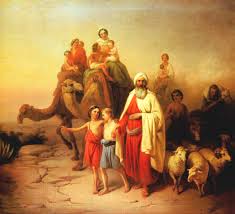Today, I want to better illustrate what it means to “frame” the gospel. This is a major aspect of the model of contextualization suggested in One Gospel for All Nations.
I will prepare you to see why Paul says that the Abrahamic covenant is equivalent to the gospel (Gal 3:8), which will be the subject of an upcoming post.

In Galatians 3:8, Paul says,
And the Scripture, foreseeing that God would justify the Gentiles by faith, preached the gospel beforehand to Abraham, saying, “In you shall all the nations be blessed.”
N. T. Wright helps us understand the context of the chapter. He correctly observes that Paul, in Gal 3, like Rom 4, seems intent to “expound the meaning of the Abraham story.”
When we try to gain a perspective on the section as a whole, one of the most noticeable things is the way in which Abraham frames the argument of chapter 3. After the opening challenge (3:1–5), Abraham is introduced, with quotations from Genesis chapters 15, 12 and 18 in quick succession. As with Romans 4, Paul seems intent on expounding the meaning of the Abraham story, and on doing so with three things particularly in mind.
First, he knows that Genesis 15 is the covenant chapter: this is where God establishes his covenant, including the promise about the redeeming event of the Exodus.
Second, he insists that Abraham was promised a worldwide family: God said that he would bless all the nations “in Abraham.”
Third, he draws particular attention to the fact that the characteristic of this worldwide family, if its members are to be true to their founding charter, is pistis: Abraham believed God … so “the people of faith are blessed along with faithful Abraham.” (Paul and the Faithfulness of God, 861)
Accordingly, we can see Paul establishing a broad framework for the gospel.
What is the gospel’s “framework”?
By “framework,” I refer to the language, images, and narrative logic that writers frequently use to present the gospel. We can thus discern content and emphases. In One Gospel for All Nations, I explain three themes that biblical writers use to frame the gospel. They consistently use at least one of the following three motifs: creation, covenant, and kingdom.
By understanding the gospel’s framework, we can:
* define what constitutes a gospel context
* define the dilemma or problem that is overcome
* determine the goal of the gospel
* identify key terms
For example, we should note how themes like “seed”, “promise”, inheritance, and justification fit together to form a coherent narrative that shapes the argument of Galatians 3 and Romans 4.
* understand why the gospel concerns the Jews & Gentiles (two social groups, not merely individuals)
* understand how the gospel integrates various aspects of the biblical story, including the ministry of the Spirit among God’s people
The gospel’s framework balances various themes and doctrines, many of which can be overemphasized due to tradition; others fade into the background of the biblical story and so get overlooked.
(This post is part of a series introducing my new book One Gospel for All Nations: A Practical Approach to Biblical Contextualization. For other posts in the series, click here.)













